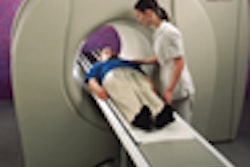Using ultrasound or CT to monitor patients with small abdominal aortic aneurysms (AAA) is just as safe as performing major open surgery to correct the lesions, according to an eight-year study. Researchers from the Minneapolis VA Medical Center presented their conclusions at last month's American Heart Association conference in New Orleans.
"Aortic aneurysm is the 13th leading cause of death in the United States and most of these deaths are due to rupture of the AAA," said Dr. Frank Lederle, professor of medicine at the University of Minnesota and a clinician at the VA Medical Center. About 9,000 such deaths occur each year, he added.
Although surgery has been recommended for aneurysms 4 cm in diameter and larger, there has been some controversy regarding the appropriate course of action for smaller lesions, especially those in the middle zone between 4 cm and 5 cm.
Doctors have debated at what point the aneurysm becomes so dangerous that the risk of rupture -- which usually results in death -- outweighs the risk of undergoing the difficult open AAA repair operation, Lederle said. The diameter of the AAA is the strongest known predictor of rupture, but small aneurysms are more common than the larger ones, he said. In 1992, the Society for Vascular Surgery recommended elective surgery for patients with AAAs larger than 4 cm.
About 1,136 veterans took part in the VA's Aneurysm Detection and Management (ADAM) study, which followed treatment and outcomes over an average of five years. Because the study was conducted in VA centers, 99% of the patients in the study were men with ages ranging from 50 to 79 years. About 42% of these patients had coronary artery disease.
If imaging techniques discovered an AAA between 4 and 5.5 cm, patients were randomized to receive either surgery within six weeks or they were followed every six months by ultrasound or CT to assess the size of the aneurysm.
Lederle said that after eight years, there were 141 deaths among the 569 patients who were placed in the surgery cohort, compared with 121 deaths among 567 patients in the surveillance cohort. The difference was not considered statistically significant, Lederle said.
During the course of the study, 92% of the patients who were assigned to surgery had undergone the procedure, and despite the extensive operation, mortality at 30 days was very low, Lederle said. There was a 2.1% percent operative mortality in the surgery group, and a 1.5% mortality among those who were originally assigned to surveillance, but later went on to receive surgery.
Notably, about 61% percent of the surveillance group eventually underwent the operation, including about 8.8% of patients who had surgery even though they were still within the protocol window for watchful waiting. Lederle said most of the protocol violations were patient-initiated.
The ADAM study found that "long-term survival is not improved by repair of AAA smaller than 5.5 cm when compared with imaging every six months, even when operative mortality is very low," Lederle said. "Deferring repair until the AAA has enlarged to 5.5 cm does not increase operative mortality, and rupture is rare in AAA smaller than 5.5 cm."
By Edward SusmanAuntMinnie.com contributing writer
December 5, 2000
Click here to post your comments about this story. Please include the headline of the article in your message.
Copyright © 2000 AuntMinnie.com




















